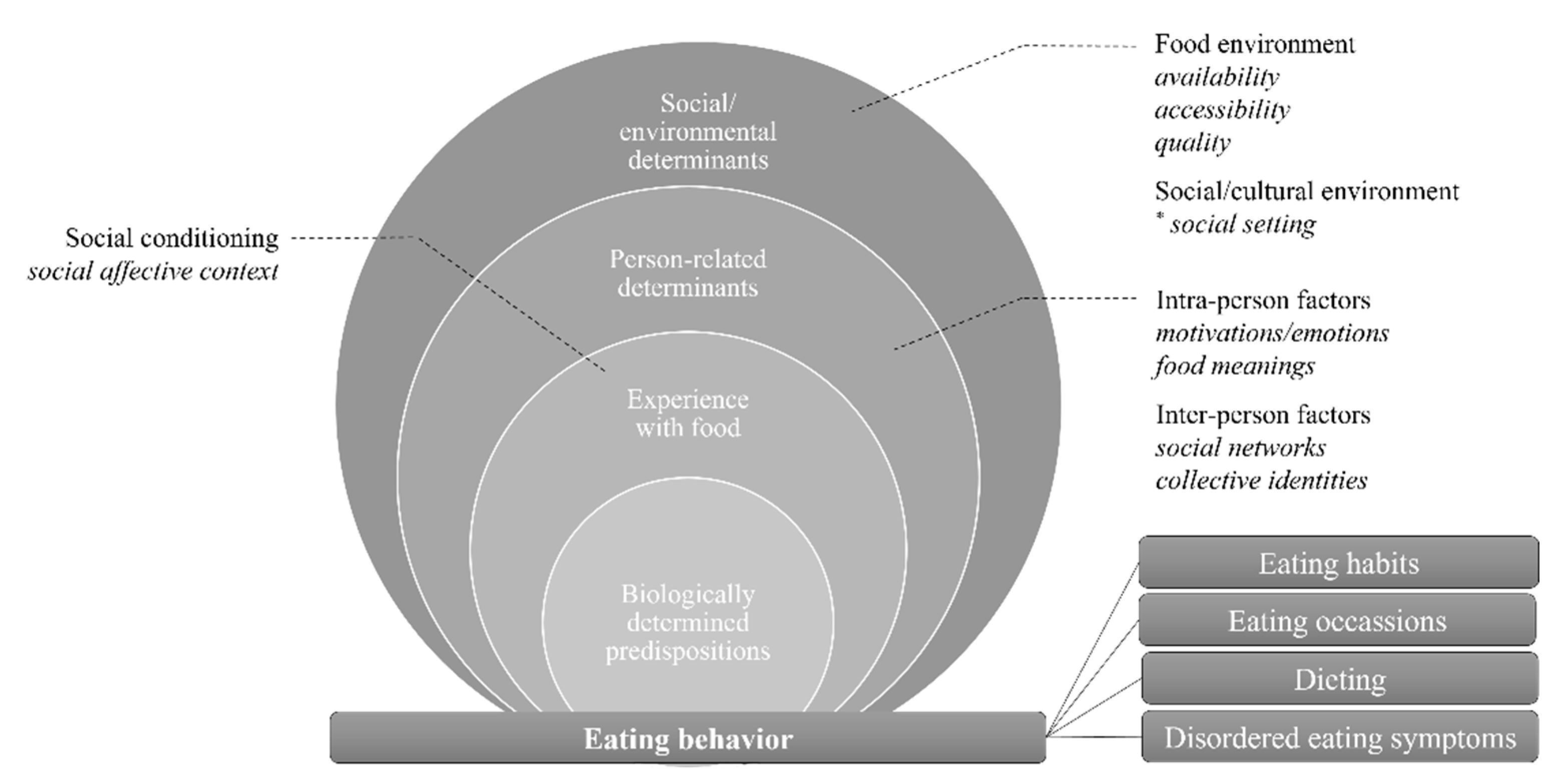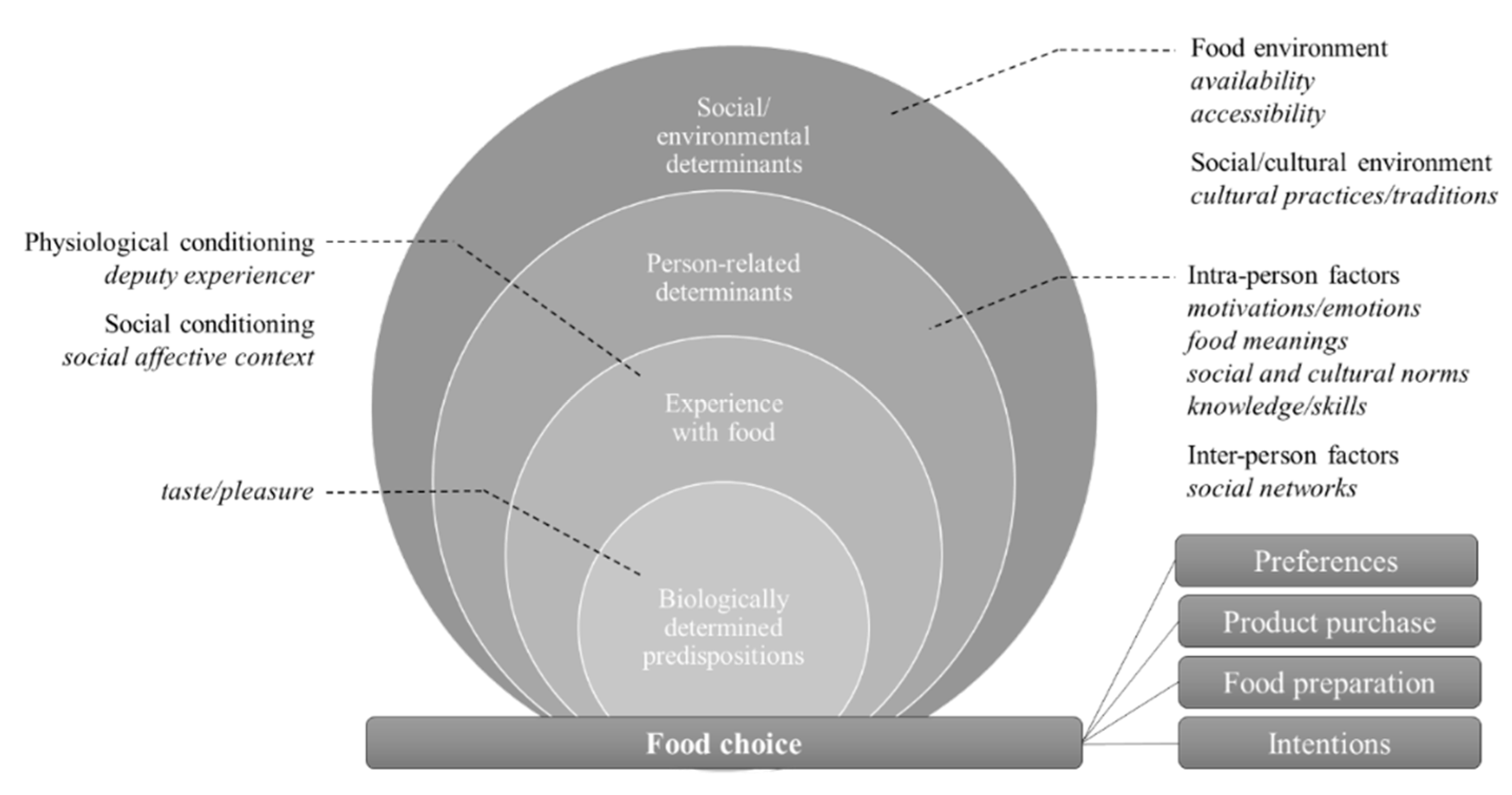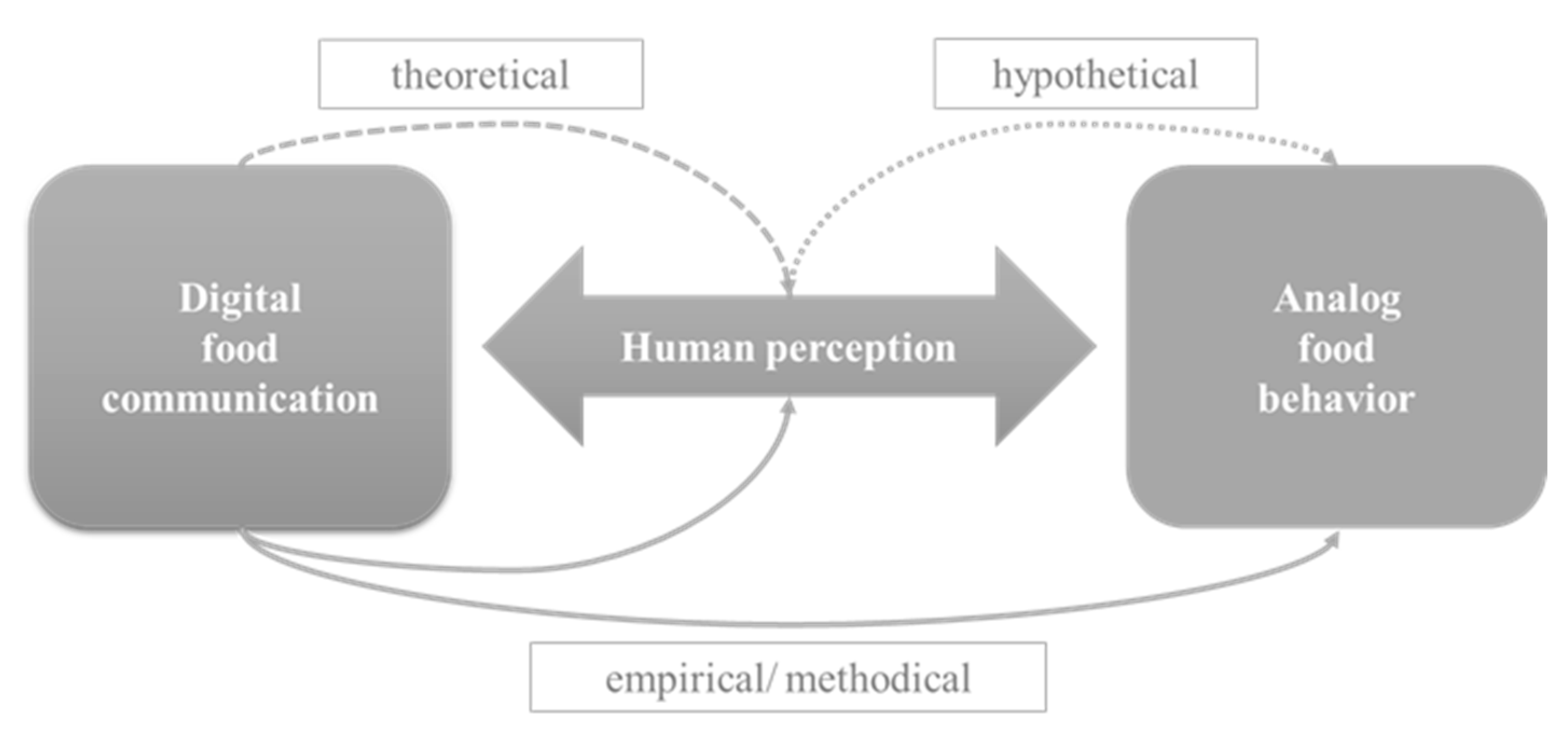Exploring the Linkages of Digital Food Communication and Analog Food Behavior: A Scoping Review
Abstract
:1. Introduction
2. Analytical Frames: Food Behavior Areas and Social-Ecological Model of Food Behavior
3. Materials and Methods
3.1. Search Strategy
3.2. Eligibility Criteria
3.3. Data Extraction and Analysis
4. Results
4.1. Overview of Included Studies
4.2. Synthesis of Results
4.2.1. Linkages of Digital Food Communication and Analog Eating Behavior
4.2.2. Linkages of Digital Food Communication and Analog Food Choice
4.2.3. Linkages of Digital Food Communication and Analog Dietary Intake
5. Discussion
5.1. Summary of Evidence
5.2. Interpretation
5.3. Implications for Research and Practice
5.4. Strengths and Limitations
Supplementary Materials
Author Contributions
Funding
Institutional Review Board Statement
Conflicts of Interest
References
- DataReportal. Digital 2021: July Global Statshot Report. Available online: https://datareportal.com/?utm_source=Statista&utm_medium=Data_Citation_Hyperlink&utm_campaign=Data_Partners&utm_content=Statista_Data_Citation (accessed on 16 September 2021).
- Kelly, Y.; Zilanawala, A.; Booker, C.; Sacker, A. Social Media Use and Adolescent Mental Health: Findings From the UK Millennium Cohort Study. EClinicalMedicine 2018, 6, 59–68. [Google Scholar] [CrossRef] [PubMed] [Green Version]
- Feldman, Z. ‘Good food’ in an Instagram age: Rethinking hierarchies of culture, criticism and taste. Eur. J. Cult. Stud. 2021, 24, 1340–1359. [Google Scholar] [CrossRef]
- Paschke, K.; Austermann, M.I.; Simon-Kutscher, K.; Thomasius, R. Adolescent gaming and social media usage before and during the COVID-19 pandemic. SUCHT 2021, 67, 13–22. [Google Scholar] [CrossRef]
- Feldman, Z.; Goodman, M.K. Digital food culture, power and everyday life. Eur. J. Cult. Stud. 2021, 24, 1227–1242. [Google Scholar] [CrossRef]
- Leer, J.; Povlsen, K.K. (Eds.) Food and Media: Practices, Distinctions and Heterotopias; Routledge: London, UK, 2016. [Google Scholar]
- Lupton, D. Digital Food Cultures; Routledge: London, UK, 2020. [Google Scholar]
- Turner, G. Ordinary People and the Media: The Demotic Turn; SAGE: Los Angeles, CA, USA, 2010; ISBN 978-1848601673. [Google Scholar]
- Lewis, T.; Huber, A. A Revolution in an Eggcup?: SUPERMARKET WARS, CELEBRITY CHEFS AND ETHICAL CONSUMPTION. Food Cult. Soc. 2015, 18, 289–307. [Google Scholar] [CrossRef]
- Schneider, T.; Eli, K.; Dolan, C.; Ulijaszek, S. (Eds.) Digital Food Activism; Routledge: London, UK, 2018. [Google Scholar]
- Goodman, M.K.; Jaworska, S. Mapping digital foodscapes: Digital food influencers and the grammars of good food. Geoforum 2020, 117, 183–193. [Google Scholar] [CrossRef]
- Johnston, J.; Goodman, M.K. Spectacular Foodscapes. Food Cult. Soc. 2015, 18, 205–222. [Google Scholar] [CrossRef]
- Lupton, D. Cooking, eating, uploading: Digital food cultures. In The Bloomsbury Handbook of Food and Popular Culture; LeBesco, K., Naccarato, P., Eds.; Bloomsbury: London, UK; Oxford, UK; New York, NY, USA; New Delhi, India; Sydnes, Austalia, 2018; pp. 66–79. ISBN 9781474296243. [Google Scholar]
- BBC. It Is Hard to Browse through Social Media without Coming Across a banquet’s Worth of Mouth-Watering Posts, but Do These Actually Alter Your Own Food Choices? Available online: https://www.bbc.com/future/article/20211206-does-seeing-food-on-social-media-make-us-eat-more (accessed on 7 January 2022).
- Hawkins, L.K.; Farrow, C.; Thomas, J.M. Do perceived norms of social media users’ eating habits and preferences predict our own food consumption and BMI? Appetite 2020, 149, 104611. [Google Scholar] [CrossRef]
- Serenko, A.; Turel, O.; Bohonis, H. The impact of social networking sites use on health-related outcomes among UK adolescents. Comput. Hum. Behav. Rep. 2021, 3, 100058. [Google Scholar] [CrossRef]
- Bartelmeß, T. Möglichkeiten der Analyse von Social-Media-Daten für die Ernährungskommunikation. In Ernährungskommunikation; Godemann, J., Bartelmeß, T., Eds.; Springer Fachmedien Wiesbaden: Wiesbaden, Germany, 2021; pp. 291–315. ISBN 978-3-658-27313-2. [Google Scholar]
- Andersen, T.; Byrne, D.V.; Wang, Q.J. How Digital Food Affects Our Analog Lives: The Impact of Food Photography on Healthy Eating Behavior. Front. Psychol. 2021, 12, 634261. [Google Scholar] [CrossRef]
- Rogers, A.; Wilkinson, S.; Downie, O.; Truby, H. Communication of nutrition information by influencers on social media: A scoping review. Health Promot. J. Aust. 2021. [Google Scholar] [CrossRef] [PubMed]
- Samson, L.; Buijzen, M. How media appeals depicting social eating contexts increase the appetitive motivational processing of healthy foods. Appetite 2021, 167, 105582. [Google Scholar] [CrossRef] [PubMed]
- Qutteina, Y.; Hallez, L.; Raedschelders, M.; de Backer, C.; Smits, T. Food for teens: How social media is associated with adolescent eating outcomes. Public Health Nutr. 2022, 25, 290–302. [Google Scholar] [CrossRef] [PubMed]
- Jauho, M.; Pääkkönen, J.; Isotalo, V.; Pöyry, E.; Laaksonen, S.-M. How do trendy diets emerge? An exploratory social media study on the low-carbohydrate diet in Finland. Food Cult. Soc. 2021, AHEAD-OF-PRINT. 1–26. [Google Scholar] [CrossRef]
- Laakso, S.; Niva, M.; Eranti, V.; Aapio, F. Reconfiguring everyday eating: Vegan Challenge discussions in social media. Food Cult. Soc. 2022, 25, 268–289. [Google Scholar] [CrossRef]
- Kley, S.; Kleinen-von Königslöw, K.; Dunker, A. Media Diets of Vegetarians. How News Consumption, Social Media Use and Communicating with One’s Social Environment are Associated with a Vegetarian Diet. Environ. Commun. -A J. Nat. Cult. 2022, AHEAD-OF-PRINT. 1–26. [Google Scholar] [CrossRef]
- Stok, F.M.; Renner, B.; Allan, J.; Boeing, H.; Ensenauer, R.; Issanchou, S.; Kiesswetter, E.; Lien, N.; Mazzocchi, M.; Monsivais, P.; et al. Dietary Behavior: An Interdisciplinary Conceptual Analysis and Taxonomy. Front. Psychol. 2018, 9, 1689. [Google Scholar] [CrossRef] [Green Version]
- Contento, I.R.; Koch, P. (Eds.) Chapter 2: Determinants of Food Choice and Dietary Change: Implications for Nutrition Education. In Nutrition Education: Linking Research, Theory, and Practice, 4th ed.; Jones & Bartlett: Ontario, ON, Canada, 2021. [Google Scholar]
- Krogager, S.G.S.; Leer, J. Doing Digital Food Studies. In Research Methods in Digital Food Studies; Leer, J., Krogager, S.G.S., Eds.; Routledge: Abingdon, UK; New York, NY, USA, 2021; pp. 1–11. [Google Scholar]
- Shepherd, R. Influences on food choice and dietary behavior. Forum Nutr. 2005, 57, 36–43. [Google Scholar] [CrossRef]
- Ajzen, I. The theory of planned behavior. Organ. Behav. Hum. Decis. Processes 1991, 50, 179–211. [Google Scholar] [CrossRef]
- Rosenstock, I.M. Why People Use Health Services. Milbank Meml. Fund Q. 1966, 44, 94. [Google Scholar] [CrossRef] [Green Version]
- Tricco, A.C.; Lillie, E.; Zarin, W.; O’Brien, K.K.; Colquhoun, H.; Levac, D.; Moher, D.; Peters, M.D.J.; Horsley, T.; Weeks, L.; et al. PRISMA Extension for Scoping Reviews (PRISMA-ScR): Checklist and Explanation. Ann. Intern. Med. 2018, 169, 467–473. [Google Scholar] [CrossRef] [PubMed] [Green Version]
- Davies, B.; Turner, M.; Udell, J. Add a comment how fitspiration and body positive captions attached to social media images influence the mood and body esteem of young female Instagram users. Body Image 2020, 33, 101–105. [Google Scholar] [CrossRef] [PubMed]
- Marino, S. Digital food and foodways: How online food practices and narratives shape the Italian diaspora in London. J. Mat. Cult. 2018, 23, 263–279. [Google Scholar] [CrossRef]
- Dowler, E.; Kneafsey, M.; Cox, R.; Holloway, L. ‘Doing Food Differently’: Reconnecting Biological and Social Relationships through Care for Food. Sociol. Rev. 2009, 57, 200–221. [Google Scholar] [CrossRef]
- Middha, B. Everyday digital engagements: Using food selfies on Facebook to explore eating practices. Commun. Res. Pract. 2018, 4, 291–306. [Google Scholar] [CrossRef]
- Onorati, M.G.; Giardullo, P. Social media as taste re-mediators: Emerging patterns of food taste on TripAdvisor. Food Cult. Soc. 2020, 23, 347–365. [Google Scholar] [CrossRef]
- Raggatt, M.; Wright, C.J.C.; Carrotte, E.; Jenkinson, R.; Mulgrew, K.; Prichard, I.; Lim, M.S.C. “I aspire to look and feel healthy like the posts convey”: Engagement with fitness inspiration on social media and perceptions of its influence on health and wellbeing. Bmc Public Health 2018, 18, 1002. [Google Scholar] [CrossRef] [PubMed]
- Walsh, M.J.; Baker, S.A. Clean eating and Instagram: Purity, defilement, and the idealization of food. Food Cult. Soc. 2020, 23, 570–588. [Google Scholar] [CrossRef]
- Easton, S.; Morton, K.; Tappy, Z.; Francis, D.; Dennison, L. Young People’s Experiences of Viewing the Fitspiration Social Media Trend: Qualitative Study. J. Med. Internet Res. 2018, 20, e219. [Google Scholar] [CrossRef] [Green Version]
- Holmberg, C.; Berg, C.; Dahlgren, J.; Lissner, L.; Chaplin, J.E. Health literacy in a complex digital media landscape: Pediatric obesity patients’ experiences with online weight, food, and health information. Health Inform. J. 2019, 25, 1343–1357. [Google Scholar] [CrossRef]
- Cavazos-Rehg, P.A.; Krauss, M.J.; Costello, S.J.; Kaiser, N.; Cahn, E.S.; Fitzsimmons-Craft, E.E.; Wilfley, D.E. “I just want to be skinny.”: A content analysis of tweets expressing eating disorder symptoms. PLoS ONE 2019, 14, e0207506. [Google Scholar] [CrossRef] [PubMed]
- Huang, Y.; Huang, D.; Nguyen, Q.C. Census Tract Food Tweets and Chronic Disease Outcomes in the US, 2015-2018. Int. J. Environ. Res. Public Health 2019, 16, 975. [Google Scholar] [CrossRef] [PubMed] [Green Version]
- Peng, Y. Sharing food photographs on social media: Performative Xiaozi lifestyle in Young, middle-class Chinese urbanites’ WeChat ‘Moments’. Soc. Ident. 2019, 25, 269–287. [Google Scholar] [CrossRef] [Green Version]
- Vydiswaran, V.G.V.; Romero, D.M.; Zhao, X.; Yu, D.; Gomez, I.; Lu, J.X.; Iott, B.E.; Baylin, A.; Jansen, E.; Clarke, P.; et al. Uncovering the relationship between food-related discussion on Twitter and neighborhood characteristics. J. Am. Med. Inf. Assoc. 2020, 27, 254–264. [Google Scholar] [CrossRef] [PubMed]
- Laguna, L.; Fiszman, S.; Puerta, P.; Chaya, C.; Tarrega, A. The impact of COVID-19 lockdown on food priorities. Results from a preliminary study using social media and an online survey with Spanish consumers. Food. Qual. Prefer. 2020, 86. [Google Scholar] [CrossRef]
- Borah, P.; Xiao, X. The Importance of ‘Likes’: The Interplay of Message Framing, Source, and Social Endorsement on Credibility Perceptions of Health Information on Facebook. J. Health Commun. 2018, 23, 399–411. [Google Scholar] [CrossRef] [PubMed]
- Coates, A.E.; Hardman, C.A.; Halford, J.C.G.; Christiansen, P.; Boyland, E.J. “It’s Just Addictive People That Make Addictive Videos”: Children’s Understanding of and Attitudes towards Influencer Marketing of Food and Beverages by YouTube Video Bloggers. Int. J. Environ. Res. Public Health 2020, 17, 449. [Google Scholar] [CrossRef] [Green Version]
- Castello-Martinez, A.; Tur-Vines, V. Obesity and food-related content aimed at children on YouTube. Clin. Obes. 2020, 10, e12389. [Google Scholar] [CrossRef]
- Coates, A.E.; Hardman, C.A.; Halford, J.C.G.; Christiansen, P.; Boyland, E.J. Social Media Influencer Marketing and Children’s Food Intake: A Randomized Trial. Pediatrics 2019, 143, e20182554. [Google Scholar] [CrossRef] [Green Version]
- Cavazza, N.; Graziani, A.R.; Guidetti, M. Impression formation via #foodporn: Effects of posting gender -stereotyped food pictures on instagram profiles. Appetite 2020, 147, 104565. [Google Scholar] [CrossRef]
- Coates, A.E.; Hardman, C.A.; Halford, J.C.G.; Christiansen, P.; Boyland, E.J. Food and Beverage Cues Featured in YouTube Videos of Social Media Influencers Popular With Children: An Exploratory Study. Front. Psychol. 2019, 10, 2142. [Google Scholar] [CrossRef] [PubMed]
- Hoffman, E.W.; Austin, E.W.; Pinkleton, B.E.; Austin, B.W. An Exploration of the Associations of Alcohol-Related Social Media Use and Message Interpretation Outcomes to Problem Drinking Among College Students. Health Commun. 2017, 32, 864–871. [Google Scholar] [CrossRef] [PubMed]
- Cramer, J.M.; Greene, C.P.; Walters, L.M. (Eds.) Food as Communication: Communication as Food; Peter Lang: New York, NY, USA, 2011. [Google Scholar]
- Lizie, A. Food and communication. In Routledge International Handbook of Food Studies; Albala, K., Ed.; Routledge: London, UK, 2012; pp. 27–38. ISBN 9780203819227. [Google Scholar]
- Blumer, H. Symbolic Interactionism; Prentice-Hall: Englewood Cliffs, NJ, USA, 1969. [Google Scholar]
- Mead, G.H. Mind, Self, and Society from the Standpoint of a Social Behaviorist; University of Chicago Press: Chicago, IL, USA, 1934. [Google Scholar]
- Giddens, A. The Constitution of Society; Policy Press: Cambridge, UK, 1984. [Google Scholar]
- Goffman, E. The Presentation of Self in Everyday Life; The Overlook Press: New York, NY, USA, 1959. [Google Scholar]
- Schmidt, J.-H. Social software: Facilitating information-, identity- and relationship-management. In BlogTalks Reloaded: Social Software-Research & Cases; Burg, T.N., Schmidt, J.-H., Eds.; Books on Demand: Norderstedt, Germany, 2006; pp. 31–49. [Google Scholar]
- Long, L.M. Meaning-Centered Research in Food Studies. In Food Culture: Anthropology, Linguistics and Food Studies; Chrzan, J., Brett, J., Eds.; Berghahn Books: Oxford, UK, 2017; pp. 204–217. ISBN 9781785332906. [Google Scholar]
- Kent, R. Digital Food Tracking: Combining traditional and digital ethnographic methods to identify the influence of social media sharing of helath and foods upon user’s everyday lives. In Research Methods in Digital Food Studies; Leer, J., Krogager, S.G.S., Eds.; Routledge: Abingdon, UK; New York, NY, USA, 2021; pp. 143–163. [Google Scholar]





Publisher’s Note: MDPI stays neutral with regard to jurisdictional claims in published maps and institutional affiliations. |
© 2022 by the authors. Licensee MDPI, Basel, Switzerland. This article is an open access article distributed under the terms and conditions of the Creative Commons Attribution (CC BY) license (https://creativecommons.org/licenses/by/4.0/).
Share and Cite
Bartelmeß, T.; Godemann, J. Exploring the Linkages of Digital Food Communication and Analog Food Behavior: A Scoping Review. Int. J. Environ. Res. Public Health 2022, 19, 8990. https://doi.org/10.3390/ijerph19158990
Bartelmeß T, Godemann J. Exploring the Linkages of Digital Food Communication and Analog Food Behavior: A Scoping Review. International Journal of Environmental Research and Public Health. 2022; 19(15):8990. https://doi.org/10.3390/ijerph19158990
Chicago/Turabian StyleBartelmeß, Tina, and Jasmin Godemann. 2022. "Exploring the Linkages of Digital Food Communication and Analog Food Behavior: A Scoping Review" International Journal of Environmental Research and Public Health 19, no. 15: 8990. https://doi.org/10.3390/ijerph19158990
APA StyleBartelmeß, T., & Godemann, J. (2022). Exploring the Linkages of Digital Food Communication and Analog Food Behavior: A Scoping Review. International Journal of Environmental Research and Public Health, 19(15), 8990. https://doi.org/10.3390/ijerph19158990






